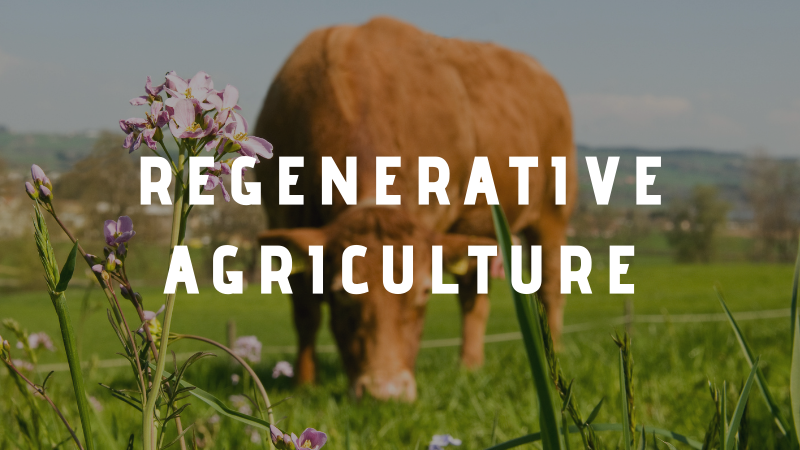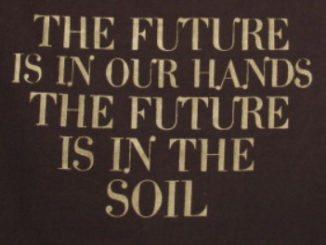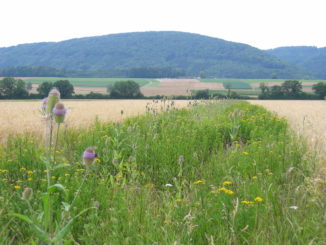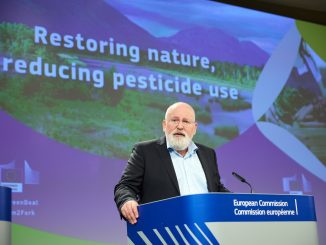The European Alliance for Regenerative Agriculture (EARA) is an independent, farmer-led coordination and political advocacy organization of the movement of regenerative agriculture at the European level. EARA is striving to enable the transformation of our agrifood ecosystems through accountable ecologic, economic and social regeneration. In this op-ed, EARA outlines a critique of the flawed ways it sees farming being supported currently, while offering another approach – one grounded in the biological processes of photosynthesis performance and soil cover: KPIs for a regenerative future.
An appeal by the Founding Farmers of EARA to join us in our journey to farm for regeneration and advocate together to re-root Europe towards a prosperous future.
Prelude
Do we believe farming for regeneration is easy? No.
Farming for regeneration might very well be the mightiest multidisciplinary profession of all. Especially in current times, when climate change as well as bureaucratic, political-economic, and geopolitical developments are making farming for regeneration harder by the day.
Yet, still, we want to stress that it is our immense privilege, as farmers, to be in the position to have the chance to farm for regeneration. Our families have access to land, knowledge, networks and tools, when others do not even have access to clean water, food and shelter.
It is our obligation to use that privilege to educate and support everyone involved in our agrifood ecosystems. And truly everyone is involved in our agrifood ecosystems – from the bacteria in our soils to the highest executives in governments and hedge-funds.
A system misguided by wrong paradigms
Currently, most public servants and politicians that control the regulatory, market and subsidy environments, in which we farmers try to farm for regeneration, are misguided by decades of education with outdated paradigms and narrow self-interest, as well as by constant lobbying of special interests.
Hence, our societies are pushed ever deeper into the rabbit holes of accelerating bureaucratisation, supposedly for control, order, and safety, in these times of havoc-wreaking crises. Sadly, this short-term prescriptive approach yields mutual alienation, decontextualisation and countless resources spent in vain that could be invested much more wisely.
Contrary to current policy discourse euphoria, we caution that the Strategic Dialogue on the Future of Agriculture by the European Commission does not fundamentally change this paradigm of policy making by itself, as the experience of the German Strategic Dialogue proves to the distress of family farming, the environment, animal welfare and citizen health in Germany.
Europe’s farmer protests are an expression of the frontline experience of climate change in the midst of bureaucracy’s life-sucking ‘paper wars’ on trust, diversity, context-specificity, planning security, adaptation and capacities.
The approach to governance in which we are stuck is hostile to free initiative and best effort – not to mention peer-to-peer learning, differentiation, emergence and mutual aid.
Farmers for the rescue
Only us farmers can envision the enabling environment that is required for farmers to be successful along their context-specific regeneration journeys. Regenerating farmers know best how to create emergent, productive and flourishing environments.
We know this work needs long-term and holistic planning. It does not need prescribing bureaucracies, but instead agile and constant adaptation by self-empowering agents. Not reductionistic and short-term drugs for hollow growth (like monetary remuneration of single measures for farmers, plowing for mineralization or synthetic nitrogen as ‘nutrition’ for plants), but instead vital and enabling milieus for self-regulating, healthy, strong, cooperating, and productive organisms – farmers, plants and animals alike.
We defined four principles for such regenerating milieus:
It is imperative that any conception of regenerating governance must first enable self-governance, trust and a shared and steadfast commitment to ethical, economical, ecological, rational and consensually agreeable outcomes.
We need a policy and governance approach that is inclusive, non-dogmatic and transformation-enabling. An approach that can pick up every farmer and every plot at its current agro-economic and -ecological state, to encourage and enable their journeys of regeneration. We need to root the agency for this regenerative transformation firmly with the farmers.
Simple & farmer-centric governance to enable and support context-specific journeys of regeneration
Our proposal for re-imagining the governance of agrifood ecosystems has these imperatives at heart.
Our proposal is spelled out in detail for the European context more specifically the Common Agricultural Policy, but the approach, we humbly hold, is universally applicable. It might very well be the greatest opportunity to use the $851 billion of global annual agricultural subsidies, in the most meaningful ways possible.
The pioneers of European farming know that new understandings in the sciences of ecology and agronomy go hand in hand with a farmer-led revolution of agricultural praxes, that lifts the productivity of ‘farming with nature’ to a new level – the true 4th agricultural revolution. This opens the way for an exciting and promising leap in agricultural and governance innovation, at a time when it is critically needed.
We deem context-specific photosynthesis performance (Net Primary Productivity, NPP) and soil cover as the most basic KPI (Key Performance Indicator) of agricultural management per land area for the unfolding 4th agricultural revolution. They are the key most basic yearly result-based indicators of the context-specific performance of land use management. Optimally, they would be complemented with the outcome-based indicator soil health and the result-based indicator resource efficiency.
Photosynthesis performance, net primary productivity (NPP) and vital living biomass
NPP serves as an indicator for the carbon assimilation through photosynthesis on an area of land, typically measured over one year. NPP can indicate the development of the land’s functions for biodiversity, water purification and detoxification, as well as the development of the nutritional value of the food produced on that land. NPP indicates how well the area of land was cooled and moisturised by plants through (evapo)transpiration, which enables habitats for vital biodiversity and stabilisation of the biosphere. NPP can thus indicate the effects of land use management on water cycles (water management performance).
So writes the European Commission’s Joint Research Centre in its World Atlas of Desertification:
“In fact, many ecosystem services are positively correlated with net primary production (NPP), including food production, climate regulation, purification of water, maintenance of nutrients, healthy soils, carbon sinks, biodiversity, and aesthetic landscape function.“105
A new (20240 study attested that soil health is associated with higher primary productivity in arable and grasslands across Europe.
Farming for biodiversity, water, carbon, food and fiber according to an up-to-date understanding of agronomic and ecological sciences, works through farming for net primary productivity (NPP) and soil health. More living plants in an area that are doing photosynthesis lead to more protection of cash crops against extreme weather conditions and richer crop nutrition by more vital soil microbiomes.
“The emphasis must be based on living soil and plant sciences to maximize photosynthesis to capture CO2 […] and maximize root exudations to feed […] the soil microbiome […].”
– André Leu, Adjunct Professor South Seas University, International Director Regeneration International, Ambassador IFOAM Organics International, Farmer in Australia
Soil Health and Cover
The performance of the soil’s microbial engines, and therefore their capability of efficiently and effectively feeding crops, biodiversity and natural cycles, can be derived from information indicating how well the soil is protected by cover throughout the year. We propose to consider soil covered if it has either >5cm mulch, >8cm residue/structure or is more than 50% covered by living plants.
Soil health, as an outcome of agronomic performance, can give a more robust and holistic indication of performance over a longer time span. However, as experienced in the Soil Monitoring and Resilience Law process, we believe it currently not politically feasible to propose in-situ soil health measurements of all agricultural plots in Europe (In Northern Ireland it is currently done). Measuring the land use management’s outcome in soil health can validate more robustly the yearly result-based performance of NPP and soil protection through land use management along longer time intervals, and also provides crucial information for agronomic and ecological management (i.e. micronutrient needs of the soil).
Resource Efficiency
Ultimately, the land use management’s performance on NPP, soil cover and soil health in a specific farm’s management context, ought to be compared against the efficiency with which external resources such as fertilizers, feed, diesel and pesticides are used to achieve this performance. When comparing the land use management’s performance on a plot and land use categorical basis in its pedoclimatic context, this is arguably not necessary because of equally distributed market incentives for efficiency in comparable pedoclimatic and regulatory contexts. Additionally, it is a feasibility hurdle whose operationalization might produce negative consequences for small-holder farmers.
Payment Design
We propose For the next CAP, a potential Agri-Food Just Transition Fund should be created. At the member state level, to grow resilience and positive eco-impact into agricultural sectors, to farmers should be renumerated for agroecosystem health performance as absolute and relative NPP and soil cover results per year and per hectare.
Agroecosystem health performance-based payments should be responsive to:
● the soil and climatic (pedoclimatic) region of the plot
● the land use category of the plot
● the performance of the other plots in that pedoclimatic region and land use category
● two kinds of results/outcomes: absolute results/outcomes (i.e. 270 days soil covered) and year-over-year development (15% more days soil covered that in the precedent year
Payments for the absolute performance of NPP and soil cover assure fairness to the pioneers of regenerative land management methods that produce the most public goods, have internalized the most externalities and arguably produce the healthiest food.
Year-over-year (YOY) results show how much NPP and soil cover performance have improved per hectare in one year. Payments based on YOY results ensure that every farmer working towards improving their yield resilience and quality, environmental impact and nature-based profitability, is enabled in their transition in a way that allows for constant on-farm learning, context-specific adaptation and long-term guidance. This reduces transfer costs and increases planning security for optimizing on-farm sustainable total factor productivity. Especially for funds going towards YOY performance, improvement should be of central importance to policy makers for assuring a livable future on this planet.
To assure the fairness and social impact of the public money being spent, the already well-known idea of capping the amount of payments that a single farmer/landowner can receive, is imperative.
Additionally, we introduce the concept of bonuses and discounts on the performance-based payments, in respect of the farm size of the recipient as a progressive redistribution of large farm’s subsidies to support small and small new farms.
If a farm is
● smaller than 5 hectares: their per hectare performance-based payment could get a bonus of multiplying by a factor of 10
● smaller than 15 hectares: factor 8
● smaller than 30 hectares: factor 5
● smaller than 50 hectares: factor 1.5.
On the contrary, if a farm is
● larger than 500 hectares, their per hectare performance-based payment could be discounted by a division factor of 3
● larger than 400 hectares: division factor 2
● larger than 300 hectares: division factor 1.5
● larger than 200: division factor 1.25.
Such bonus and discount mechanisms could not only preventively abate undesirable consequences (land grabbing, land price speculation, concentration of public fundings, etc.), but could also help to proactively counteract already entrenched problems, such as land ownership concentrations, unattractiveness and demographic problems of agricultural labor.
Additionally, not paying the lowest brackets of performers can be comprehended as a new option for performance-based conditionality that assures that public money flows only for genuine service to society at large while not prescribing practices to farmers that might be unreasonable or even counter productive in their individual contexts.
In our Policy Paper (see link below) we describe in detail the technological (EU Copernicus program), economic (possible sizes of payments), governance and political aspects of a future CAP design anchored in such payments.
Resume
With a switch to fair and simple payments for agroecological performance, public payments can empower, guide and incentivise farmers context-specifically along the core insights of the true 4th agricultural revolution, and also foster drastic simplification and planning security with a long-term perspective in the agricultural sector.
The proposed reform has the potential to:
- Bring the youth back to farming, and
- Leverage fairness and innovation in the sector for a future-proof food security, as well as
- Value-based and vibrant rural livelihoods in Europe and beyond.
If we farm and advocate together, we can enable the urgently-needed regeneration of our agrifood ecosystems and create a chance to positively re-engage with our communities, our regions, our nations and our European continent for peace and economic stability, on a planet supporting life.
The ideas presented are not exhaustive. Our Policy Paper is envisioned as a fertile soil from which to co-grow support and refinement. Please be invited to share our ideas. We are ready to discuss them anywhere at any time.
Currently we are doing a pilot program that is testing the system described above. We want to look at 450 plots of pioneering farmers of all kinds throughout Europe. If you are a farmer and want to participate or know pioneering farmers that we should reach out to, please write to skraemer@eara.farm . Join us! @eara.farm
Thank you all for your amazing work – day in day out – together we farm for regeneration!
Read/download the EARA_CAP-Policy-Paper_-Towards-a-farmer-and-agroecosystem-health-centered-CAP
More
Manifesto for Regenerative Agriculture Adopted at Climate Farming Congress
CAP not Matching Europe’s Green Ambitions, say Auditors (again)
Germany | To Reduce Pesticides, Start with Nutrient Management
Brussels News Roundup – Ombudsman Launches Inquiry into CAP Fast-Track
An Agrifood Stakeholder’s Guide to the EU’s New Power Structure
CAP Strategic Plans: A European Food and Agricultural Policy for Times of War
Organic and Biodynamic Viticulture: Adapting the Vine in a Changing Climate
Letter From The Farm | Rasputin The Ram & The Ethics Of Lamb For Easter Dinner
The Myth of Climate Smart Agriculture – Why Less Bad Isn’t Good
Comparing Organic, Agroecological and Regenerative Farming part 3 – Regenerative
Re-CAP: Breaking down the breakdown of the EU’s green farming measures
“We must deliver” – The Future of Agricultural Transition in Europe
Op-Ed – The Solution to Free Half of European Arable Land from Pesticides
Germany | To Reduce Pesticides, Start with Nutrient Management










